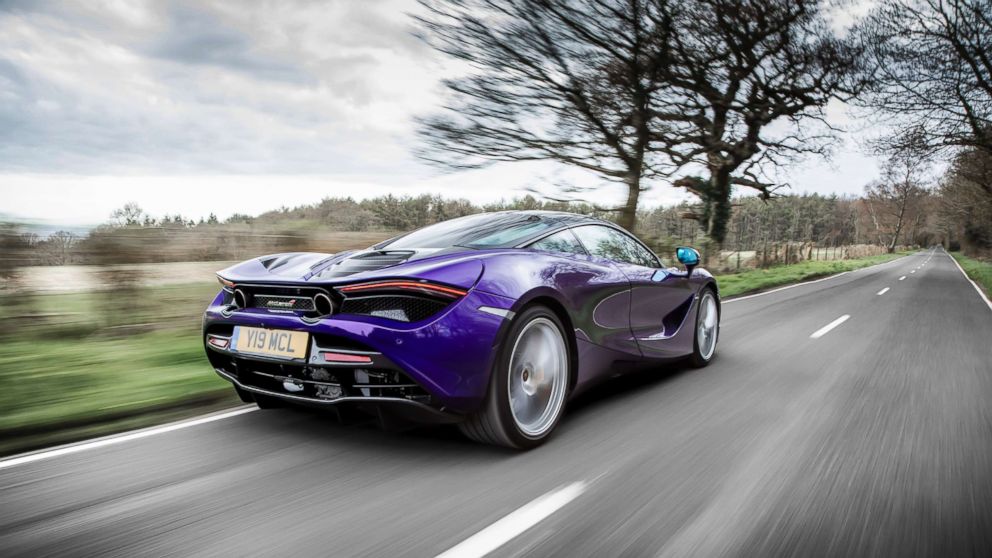


For many drivers, the best part of owning a sports car is not the blistering speeds, countless stares and zero to 60 mph acceleration.
It’s the deep, visceral burble that rings out each time the car is awakened with the push of a button.
The world’s top automakers pay extraordinary attention to a car’s acoustics. A growl can be refined or surly, luscious or overwhelming, depending on the model of the car and the brand it represents. That’s why discerning automakers have dedicated teams of experts tasked with developing and fine-tuning the pitch of an engine. It can take years of factory testing to perfect that sonorous chortle or silky purr.
This year General Motors unveiled its newest ZR1 supercar -- the fastest and most powerful Corvette ever produced in the Detroit automaker's history. It’s clear that the unique roar of the ZR1's engine was as vital to the new model’s architects as its athletic design and best-in-class performance standards expected by enthusiasts.
“This is the ultimate Corvette,” Charlie Rusher, a noise and vibration development engineer at Corvette, told ABC News. “The sound of the car had to match the aggressive styling and performance.”
(MORE: Why the new $120K ZR1 sports car is a game changer for the Corvette)Rusher studied Formula One racing videos online to pinpoint and capture the muscular sound he envisioned for the ZR1. He was so determined to get it right that it took him roughly two years and 30 iterations before he was able to match the sound in his mind with the rich hum of the ZR1.
“There was a lot of love and passion for this project,” he said. “It was a huge undertaking by the team.”
Rusher and his small team of engineers began by molding the ZR1’s acoustics with cutting-edge predictive software.
The ZR1’s exhaust system was modeled as a baseline on a computer. Rusher would add variables like gas flow rate and temperature to produce a predictable acoustic pitch. Then the engineers would analyze the sound and make the basic hardware changes necessary to attenuate the engine’s tonality.
It’s an exacting process: reducing the size or number of perforation holes on the tubes inside of a muffler can force a car engine to growl loudly.
The holes “bleed exhaust gas out of the main flow stream and into the muffler,” Rusher explained.
The more holes, the quieter the car will become.
At one point, Rusher tried removing the muffler to modulate the overwhelming wail of the ZR1’s exhaust.
“You do not want to be audibly fatigued when driving the car,” he said. “The noise can be too much on the highway.”
As it progressed from infancy to the production phase, Rusher would record the engine’s sound and recalibrate it as needed. He reached out to others for input and was not shy about stretching the limits.
“We’d constantly get feedback from the team, from the powertrain engineers,” he said. “We wanted to push the limits of any technology.”
The finished product held true to Corvette’s reputation for automotive excellence, Rusher said, and the ZR1’s (patent-pending) muffler design creates a “very aggressive sound, similar to a race car.”
Getting every detail just right before the production phase was crucial.
“You don’t want a Corvette to sound like a Mustang,” he said. “You don’t want it to sound like a Camaro. When you hear a Corvette, you know it’s a Corvette. There’s the pop, burble, crackle when you lift off the throttle.”
Even genuine devotees of high-end sports cars rarely appreciate the trial-and-error toil and rigorous testing required to create that throaty, seductive sound of a precision engine, according to Bradley Sheppard, a noise, vibration and harness engineer for McLaren Automotive’s Ultimate Series Products.
“People don’t always think about all the effort that goes into the development of the sound,” he told ABC News. “There are hours and hours of calculation and concept testing. The engine does not land in a car sounding the way it does.”
(MORE: Why British supercar maker McLaren is saying 'no' to SUVs)Like each Corvette model, every McLaren supercar must deliver its own distinct sound, a sonic calculation that inherently matches “what the vehicle needs to do,” Sheppard explained.
The McLaren Speedtail, for instance, strikes an impressive balance in producing a “powerful yet engaging” pitch, he said.
The Senna is “the ultimate track car and the most aggressive in terms of sound,” according to Sheppard. Conversely, the 4.0-liter twin-turbo V8 engine in the 720S produces a roar that’s more “tolerable for the roads,” he noted.
The biggest challenge for a top-flight sound engineer is to capture a sound that’s both distinguishable to the brand and true to the model. Among the industry’s supercar community, the sound of a McLaren engine will never be mistaken for that of a Ferrari or a Lamborghini.
“We try very hard to make our sound bespoke,” Sheppard said. “Noise is a big part of a car’s character.”
Maurizio Reggiani, Lamborghini’s chief technical officer, told ABC News that many of the Italian carmaker’s customers often want their cars to sound even louder and more muscular than they already are (the company, alas, has to abide by state and federal noise regulations).
Reggiani made a point to emphasize that every model, except for Lamborghini’s new SUV, has a naturally-aspirated engine, which produces what he describes as a more “emotional” sound than typical sports cars built with turbocharged engines.
(MORE: Inside Lamborghini's state-of-the-art factory that turns steel into automotive magic)To hear sound engineers ruminate on the process of getting the engine’s acoustics just right is to recognize the passion for excellence that goes into every detail of the construction and design of the world’s top-performing sports cars.
“Nobody can do the sound of a Lamborghini,” Reggiani said. “Our sound is engineered to be Lamborghini. It’s something specific to us.”
Each new model also presents a fresh opportunity for Reggiani’s team.
Take the Urus SUV, which challenged Reggiani’s best and brightest to figure out how to keep the Lamborghini’s signature harmonics intact with a turbo-charged V8 engine.
“It took six months to tune the sound,” Reggiani acknowledged with a mixture of pride and resignation. “There were simulations, prototypes [and] testing. It’s the first time we had an engine in the front and the muffler in the rear.”
In the end, Reggiani relied on instinct.
“Your ear is the judge,” he said.